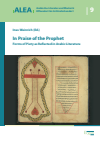Zusammenfassung
Im Zentrum stehen Praktiken der Prophetenverehrung ab dem 13. Jahrhundert und ihr literarischer Niederschlag. In erster Linie ist das bisher wenig erforschte Gebiet der Prophetenlobdichtung (al-madīḥ an-nabawī) zu nennen. Der Band zeigt ihre vielfältigen Ausdrucksformen als persönliche Frömmigkeitsform, literarischer Wettstreit oder musikalische Aufführung. Neben Bearbeitungen des bekannten Burda-Gedichts aus dem 13. Jahrhundert finden sich umgangssprachliche strophische Gedichte, mawlid-Texte, Prophetenlob in Maqāmen und in der marokkanischen Musiktradition (nūba) sowie Gebetbücher und Briefe an das Grab des Propheten. Zahlreiche einflussreiche Werke und Personen werden zum ersten Mal in der europäisch-sprachigen Forschung vorgestellt.
Abstract
This volume provides a contribution to Arabic literary history from an exceptional perspective. It examines the literary expression of veneration of the prophet Muhammad, primarily the hitherto little researched field of praise poetry to the prophet (al-madīḥ an-nabawī) and its diverse manifestations – as a personal form of piety, literary contest, or musical performance. Alongside emulations of the well-known 13th-century Mantle Ode, the volume treats strophic poetry in the vernacular, mawlid texts, prophetic praise in the maqāma genre and in the Moroccan musical tradition (nūba), as well as prayer books and letters to the Prophet's tomb. Many influential works and poets are presented for the first time in Western research.
Schlagworte
13. Jahrhundert al-madīḥ an-nabawī Arabische Literatur Burdah Frömmigkeit Mamlukenzeit Maqāmāt marokkanische Musiktradition mawlid Prophetenlobdichtung Prophetenverehrung Zaǧal- Kapitel Ausklappen | EinklappenSeiten

